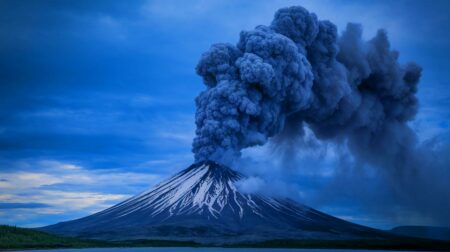| IN A NUTSHELL |
|
In a groundbreaking study, an ancient tree fossil has provided scientists with an extraordinary glimpse into a chaotic period 42,000 years ago when the Earth’s magnetic field temporarily destabilized. This unique window into the past reveals the potential impacts such events could have had on the environment and human evolution. The research unveils a story of environmental upheaval, artistic expression, and possibly even the extinction of certain species. Let’s delve into the fascinating findings of this study and explore the implications for our world today.
The Significance of Earth’s Magnetic Field
The Earth’s magnetic field is an invisible shield that protects life by deflecting solar winds and cosmic radiation. Without it, the planet would be exposed to harmful particles from space, which could strip away the atmosphere and make life as we know it impossible. This magnetic field is not static; it constantly shifts and changes over time. Every few hundred thousand years, a complete flip occurs, where magnetic north switches with magnetic south. These full geomagnetic reversals can last up to 10,000 years.
Between these major reversals, shorter disruptions known as geomagnetic excursions take place, causing temporary changes in the magnetic field. The most recent excursion, known as the Laschamps Excursion, occurred around 42,000 years ago. During this event, the magnetic poles temporarily swapped places for approximately 800 years. Such events, although brief, can have significant environmental impacts. Understanding these changes helps us appreciate the dynamic nature of our planet’s magnetic field and its critical role in sustaining life.
Electric rough terrain forklifts: an eco-friendly solution for industries pursuing sustainability
The Discovery of the Ancient Tree
The key to unlocking the secrets of the Laschamps Excursion lay in a remarkable discovery in New Zealand. During construction work, a perfectly preserved kauri tree trunk was unearthed, offering a precise timeline of the Earth’s environmental conditions during this period. The tree’s rings provided an unparalleled 1,700-year record, allowing scientists to measure and date atmospheric changes with unprecedented accuracy.
Radiocarbon data extracted from the tree revealed a spike in atmospheric radiocarbon levels, indicating a collapse in the Earth’s magnetic field. This discovery enabled researchers to create a detailed timeline of environmental changes, shedding light on the dramatic impacts of the magnetic field’s disruption. The study, published in the journal Science, used climate modeling to explore the effects of this temporary reversal, revealing significant changes in the Earth’s atmosphere, including a depleted ozone layer and increased ultraviolet radiation.
Environmental and Evolutionary Impacts
The Adams Transitional Geomagnetic Event, named after the author Douglas Adams, marked a period of intense environmental change. During this time, auroras were visible across the globe, and electrical storms were frequent due to increased ionization of the atmosphere. These phenomena would have been awe-inspiring and potentially terrifying for early humans, who might have perceived them as signs of impending doom.

The study also speculates on the impact of increased ultraviolet radiation on human behavior. It suggests that the rise in cave paintings during this period may have been a response to the need for shelter from harmful rays. The use of red ochre as a form of sunscreen is another intriguing hypothesis. Additionally, the study links the magnetic field disruption to the extinction of Neanderthals and several megafauna species, although these claims remain controversial and require further investigation.
Lessons for the Present and Future
The findings of this study offer valuable insights into how a similar geomagnetic event might affect our modern world. The current movement of the north magnetic pole and the weakening of the Earth’s magnetic field are potential indicators of an upcoming reversal. If such an event were to occur today, the consequences could be dire, potentially disrupting power grids and satellite networks due to increased cosmic radiation.
Researchers caution that while these scenarios are speculative, they highlight the importance of understanding our planet’s magnetic behavior. By studying past events, we can better prepare for future changes and mitigate potential impacts on technology and infrastructure. This research underscores the need for continued monitoring and exploration of Earth’s magnetic field to safeguard our society against unforeseen environmental challenges.
The study of the ancient tree and the Laschamps Excursion provides a captivating glimpse into Earth’s past and a reminder of the planet’s dynamic nature. As we learn more about these geomagnetic events, we gain a deeper understanding of their potential effects on our world. What other secrets does the Earth’s magnetic field hold, and how might they shape the future of life on our planet?
Did you like it? 4.5/5 (25)








Wow, 42,000 years ago is a long time! How do scientists even date something that old? 🤔
Isn’t it amazing how trees can be like time capsules? Thanks for this fascinating read! 🌲
How reliable are these findings? Can we really trust data from such ancient sources?
The idea of increased UV radiation affecting early humans is intriguing. Do we have any evidence of red ochre being used as sunscreen?
Could these findings suggest that we’re due for another magnetic reversal soon? Should we be worried?
This is incredible! I never knew Earth’s magnetic field could flip like that! 🤯
Why is the magnetic field so important for life on Earth, anyway?
What kind of technology do scientists use to study these ancient tree rings?